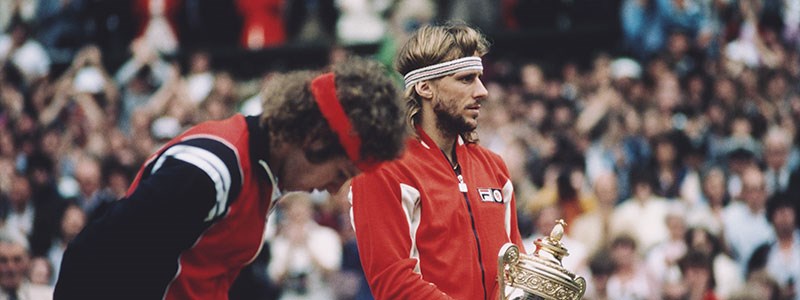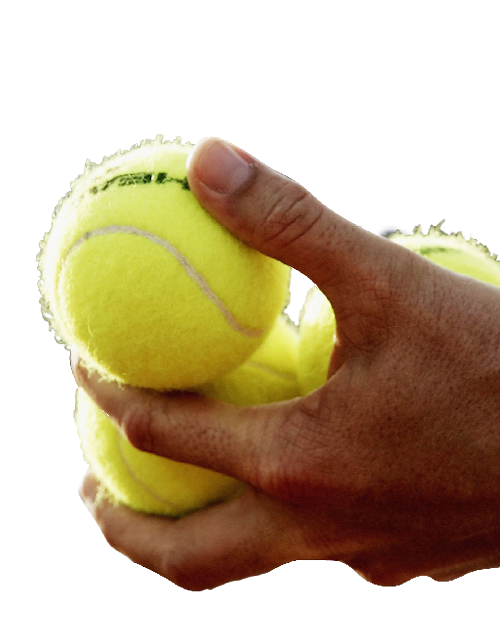Open Era 1980-1989: Rivalries, OUTFITS & the end of wooden rackets
• 6 MINUTE READ
Bjorn Borg vs John McEnroe, Martina Navratilova vs Chris Evert, the rivalries of the 1980s had a distinctly international flavour. Rackets were changing and so were the fashion statements. By Alex Sharp
Where else to start when looking at the Open Era in the 1980s than one of the most famous rivalries in sporting history?
The decade opened with the ‘Ice Man’ Bjorn Borg vying for a fifth consecutive Wimbledon up against the volatile but captivating talent of John McEnroe.
Kitted out in a bold tracksuit, the headband shielding his flowing locks from his face, Borg was the ultimate pin-up and epitomised the look for the decade. McEnroe, meanwhile, was outspoken and willing to contest the crowd, entering Centre Court to a chorus of jeers.
The contrasts, the skill, the drama; this 1980 Wimbledon final was the ultimate. So much so, it was recently made into a film simply entitled ‘Borg vs McEnroe’.
The American managed to stave off five Championship points in the pulsating 22-minute fourth set tie-break, but Borg eventually prevailed 1-6, 7-5, 6-3, 6-7(16), 8-6.

A few months later McEnroe surrendered a two-set lead, but still retained his US Open crown to gain revenge over Borg. Fast forward a summer to 1981 and the Swede’s reign at SW19 was halted by the boisterous McEnroe.
It was a changing of the guard, with Borg stunning the sporting world by announcing his retirement in 1983 at just 26-years-old.
The Borg vs McEnroe rivalry could have matched the legacy and longevity of Martina Navratilova and Chris Evert. The latter pair met on court a staggering 80 times from 1973-88, with Navratilova earning a 43-37 advantage as they split 24 Grand Slam titles in this decade (nine for Evert, 15 for Navratilova).
Evert dominated on the clay like Borg, with crafty but acutely accurate play totting up a record 125 consecutive victories on the surface.
In another striking comparison, Navratilova illustrated her doubles prowess much like McEnroe to flourish with serve and volley skills. The legendary leftie utilised her superior net game to lift six successive Wimbledon titles from 1982-87.

All of a sudden, a certain German powerhouse in the form of Steffi Graf burst onto the scene with tremendous foot speed, laser-like passing shots, and a trademark inside-out forehand.
Mats Wilander scooped three Majors on the men’s side in 1988, but Graf exceeded that to carve out a ‘Golden Slam’.
The German lifted the Australian Open without dropping a set, thrashed Natasha Zvereva 6-0, 6-0 in a 32-minute Roland Garros final, before overhauling a 5-7, 0-2 deficit to topple Navratilova’s rule at Wimbledon.
A US Open and Seoul Olympics final double over Gabriela Sabatini followed to etch an unprecedented campaign into history.
In terms of celebrations, few matched the scenes sparked by Yannick Noah winning on home clay with a court invasion at Roland Garros in 1983. Today we are accustomed to witnessing players scale the stands to their loved ones after a Grand Slam triumph, a tradition sparked by Pat Cash’s adventurous celebrations at Wimbledon in 1987.

The 1980s also marked the true advancement in racket technology. Graphite and titanium frames came into use, for example McEnroe wielded the Dunlop Max200G from 1983. Soon all the players latched onto the piercing power from a metal frame and the last wooden racket gracing the grounds at Wimbledon in the main event was seen in 1987. Ever since it has been a process of tinkering and tweaking with different compositions of metals.
The raw power from racket changes was put to fearsome use by a teenage sensation Boris Becker. He was the precursor to players such as Stefan Edberg and Pete Sampras, who built their foundations on a strong serve and powerful volleys.
The combination of ‘boom-boom’ serves and famous diving volleys saw Becker claim a Wimbledon title aged just 17, but more significantly ushered in the priority of power in the upper echelons of the sport.
Ivan Lendl was harshly perceived as a ‘choker’ having lost his first four Grand Slam finals (to the likes of Borg, Jimmy Connors, and Wilander!)
The stern Czech broke through in the 1984 Roland Garros final, reeling in McEnroe from a two-set deficit. Lendl was one of the first pros to enlist year-round trainers, to use psychologists, to analyse his diet. These were certainly the shoots of the entourages players take with them on tour today. It worked. Lendl scooped seven majors in the Eighties with an unrelenting fitness level, wearing down beleaguered opponents.

Let’s not forget that tennis was becoming more global in the Eighties, as the blockbuster rivalries were wired across the TV networks. Unsurprisingly, this had a huge impact on the look of the game.
Player outfits certainly splashed in more colour, with a pastel wave dominating the decade, but a seismic shift was the ITF ruling that fluorescent balls, instead of white, should be introduced to enhance the view on televised matches.
After some trials ‘optic yellow’ was plucked out to help spectators track the ball, with Wimbledon accepting these brighter balls during the Championships in 1986.
Another landmark difference for the Open Era arrived in 1988 regarding the surfaces. The US Open changed site in 1978 to Flushing Meadows, leaving lawns behind to duel on rubberised concrete. That left two majors on grass until the Australian Open departed the Kooyong site also for rubberised concrete courts in 1988. Wimbledon stayed true to its tradition and heritage to remain the only major hosted on the luscious green grass at the All England Lawn Tennis Club.

1988 will live long in the memory of sporting fashion too. Andre Agassi had yet to reach his peak stardom when rocking up to Flushing Meadows in New York.
His wild hair had caught the attention in the past, but his sponsor had somehow conjured up some very ‘now’ denim shorts for Agassi to wear on court. To say that the ‘acid wash’ shorts caused a stir is an understatement.
What was telling were the lengths to which kit suppliers would now go. The end of the Eighties marked the real birth of player endorsements. Adidas released numerous ranges with Graf as major labels snapped up players to wear prominent logos across tracksuits, patterned polos, and standout shorts. Agassi wasn’t the first, but it was by far the most eye-catching collection.
So, the 1980s. Rivalries ramped up interest, the TV altered the appearance, technology restructured game styles, and players became fitter, more imposing, stronger. The sport was never the same again.
Keep reading
- Open Era 1968-1979: Check out the birth of the Open Era on the British South Coast
- Find out how the Lawn Tennis Association is marking the Open Era's 50th Anniversary at West Hants Club





